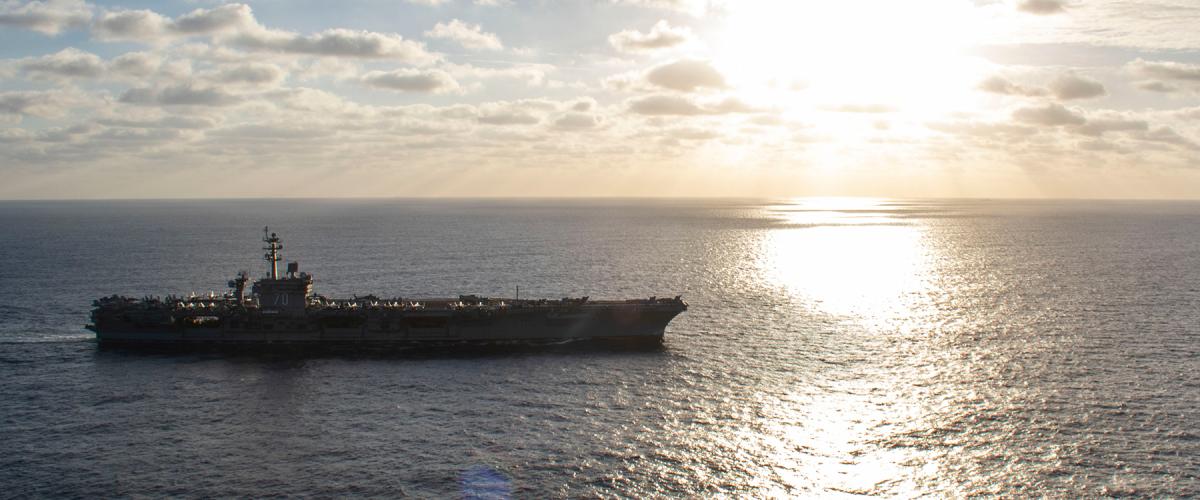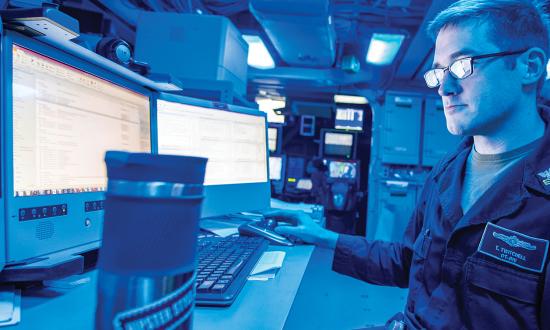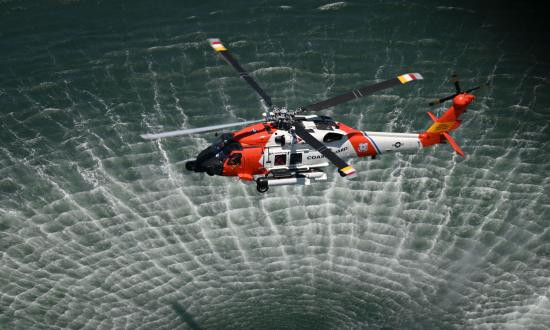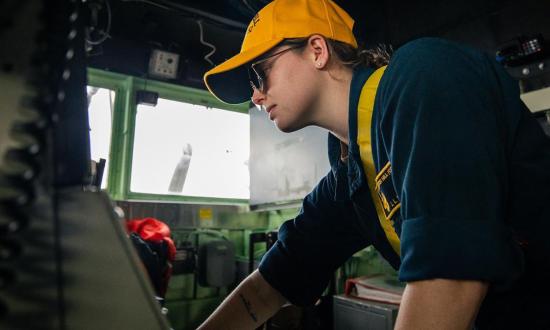For thousands of years, mariners traversing the world’s oceans did not have easy access to fresh, potable water. Sailors could easily die of thirst if they failed to prepare adequately for a long journey. Modern U.S. aircraft carriers do not suffer from this limitation. Their nuclear reactors produce the steam power that enables onboard desalination plants to create an essentially unlimited amount of potable water from seawater. Through the sustained and thorough application of engineering manpower, equipment, and taxpayer dollars over three generations, the Navy has broken entirely free of one of the major logistical shackles that impeded ocean travel for millennia. Seawater, once only considered a means of traversal and treated as an environmental hazard, is now a valuable resource that can be put to a variety of uses.
In 2022, Carrier Strike Group One’s Data Science at Sea team (hereafter “CSG-1” and “DS@S”), came to a similar conclusion about a different readily available and underutilized resource on board the USS Carl Vinson (CVN-70). Taken together, our intelligence resources, combat systems, and weapons platforms were generating terabytes of operationally relevant data every day, but only a small fraction meaningfully informed decision making. Most of it was never accessed at all. Poor knowledge-management practices, the lack of trained data scientists or software coders assigned operationally, and a stubborn devotion to Microsoft PowerPoint as a singular data visualization tool kept CSG-1’s data from providing much operational value.
To overcome these challenges, the DS@S team had to fundamentally reimagine how a carrier strike group mans, trains, and equips its information warfare capability afloat. The officers involved had to embrace a different style of naval leadership, one focused on innovating novel solutions to emerging problems vice the more traditional style of mastering and maintaining existing capabilities.
Starting From Scratch
CSG-1’s DS@S team was formally established in November 2022 with a broad mandate to use all available operational and intelligence data to solve warfighting problems at the tactical edge. The team does this by identifying issues related to unmet or emerging CSG-1 warfare requirements and developing minimum viable data-oriented solutions to address those problems. Once these software solutions (or “projects”) reach a level of maturity and demonstrate operational utility, they are presented to a program of record for further refinement, scaling, and transfer to the fleet. Currently, the DS@S team manages a portfolio of roughly a dozen projects primarily focused on battlespace awareness; counterintelligence, surveillance, reconnaissance, and targeting (C-ISRT); and maritime fires. The DS@S team has always been a mix of uniformed and civilian personnel and the current iteration features one O-5, two O-4s, two GS-13s, and two E-5s.
Since its inception, the DS@S team has benefited immensely from its favorable command climate and enthusiastic leadership. The CSG-1 commander’s interest has been critically important: He meets regularly with the team to provide feedback and guidance on projects under development and came up with the name Data Science at Sea.
Furthermore, the Vinson was the first CVN with significant Project Overmatch investment, providing the team more ready access to resources and engineering expertise from Overmatch, Naval Information Warfare Systems Command (NAVWAR), and Naval Information Warfare Center (NIWC) Pacific during the 2022–23 workup cycle. This helped DS@S transition its software projects into solutions that can be scaled across the fleet.
Those factors were certainly important to DS@S’s early successes, but they were by no means sufficient to create an entirely new capability from scratch. While the Navy does possess a large cadre of government civilian data scientists primarily working for the warfare centers, it does not man, train, or equip a uniformed military data science capability afloat or ashore. This lack of a ready Navy-wide solution to meet a perceived capability gap at the CSG level meant innovation would be required if CSG-1 personnel wanted to tackle these challenges using its data.
Innovation Leadership
Traditional approaches to naval leadership center on the idea that an individual leader should embody certain values and cultivate leadership traits to tackle a variety of complex scenarios. Operational experiences, whether one’s own or from others, should be studied so that a growing leader can consider how those core values and traits were applied to achieve mission outcomes in the past.
This approach also comes with certain assumptions, chief among them that a leader should grow where they are planted. The Navy offers a dizzying array of placement opportunities for officers of all designators. In each case, an officer is expected to adapt to and overcome different sets of challenges. The corresponding expectation is that the Navy will provide the training and resources to prepare and support service members in each of these positions. Once a leader is in the proverbial seat, they are not expected to do the job alone. Programs of records produce capabilities based on requirements that have been validated by the Office of the Chief of Naval Operations. Sailors who have received training in those capabilities form the backbone of the workforce. Leaders are then expected to lead their teams according to those values and traits. But if a leader is trying to develop and lead a team whose “capability” does not have a manning, training, or equipment plan—or even a validated requirement associated with it—then he or she is in uncharted waters.
Conceptualization, Contextualization, and Cultural Change
Creating something wholly new within the Navy—and convincing others to come along on the journey—requires a different style of leadership. First, a leader must be able to conceptualize a better system. In their 2018 article, “Leading Military Innovation, Past and Present,” Dr. Mie Augier and retired Navy Captain Wayne Hughes note that “doing things differently is difficult; but the heart of innovation is about first seeing things differently which is just as hard.”
When CSG-1’s leaders began to explore how to maintain and grow the nascent data science capability demonstrated during their previous deployment, they decided to host a workshop alongside members of Project Overmatch’s Data Pillar. It began with a leading question: “How might the Navy man, train, and equip a data science at sea capability?” This prompt allowed the group to critically explore the status quo and begin codifying what novel formal requirements for data science at sea should look like. By the end, the assembled group had collectively developed a much richer idea of what success could look like if they could find the necessary resources.
It is important to dream big, but there is a very different set of skills required to make those plans work within specific operational Navy contexts. The next step is therefore a shift from conceptualization to contextualization. Because the data science capability was not formally manned, it was unclear who would take the lead doing the program’s daily work until more personnel could be identified and onboarded. The team was lucky to have a pool of talented volunteers ready to commit their time to the cause; a lieutenant (junior grade) who had some computer science skills related to his electrical engineering degree and a civilian data scientist from Project Overmatch. This rather unique (to the Navy) civilian-military manning plan turned out even more productive than expected and has remained our preferred approach to DS@S team manning.
Contextualization is also about understanding which best practices will and will not work in a specific operational area. In many ways, at sea is the worst place in the Navy to do data science. Baseline shipboard desktop computers do not come with graphics cards. The number of software libraries available on Navy networks is limited compared with what is available for free at home. Communications on board a ship are often intermittent. Then there is the fact that staffs make plans but ships own and maintain networks, which often causes tension.
In each of these cases, innovation leadership depends not only on understanding the operational context but also a willingness to aggressively adapt (or reject) solutions that worked elsewhere. Following this philosophy, the DS@S team deprioritized or scrapped projects that failed to meet performance standards or required more effort than they were worth.
The final step of innovation leadership is focusing on cultural change. Though this is somewhat counterintuitive alongside the discussion of resource constraints, DS@S has always attempted to go above and beyond. This was by necessity: A small data science team focused on small, manageable problems making marginal gains would eventually die off because of a lack of resources. But a small team focused on solving large, seemingly intractable problems would be better positioned to demonstrate real value to the organization and ask for more resources. DS@S needed to grow, or it would die.
This required a mindset shift. Because of resource constraints, the Navy often defaults to a scarcity mindset in which resources must be hoarded and not wasted on seemingly frivolous or quixotic endeavors. By comparison, an abundance mindset is one in which losses can be recouped with minimal pain. Sometimes, it makes sense to invest those resources in a long-shot effort with a potentially huge payoff. An abundance mindset helps inform the DS@S team’s project selection criteria: Since the start of deployment, we have created three new projects focused on different aspects of maritime fires as we realized this is an area in which advances by CSG-1 could help inform a broader modernization effort across the Navy.
One year after its founding, the DS@S team’s emphasis on working closely with watchstanders and warfare commanders to develop tailored software solutions has created a mindset shift across all of CSG-1. If operational planners or the intelligence team run into an issue, they can request DS@S support, which typically results in a new type of data visualization or automated workflow. A few weeks into our current deployment, the number of seemingly intractable data-management and visualization issues has shrunk dramatically. As we develop the requirements documentation necessary to scale DS@S across the fleet, we hope to imbue each new DS@S team with this approach, combining innovation with customer service.
Looking Forward
Innovation leadership and traditional leadership are complementary, not adversarial concepts. At almost every stage of an officer’s career, he or she will be expected to embody the Navy’s core values and cultivate leadership traits such as judgment, tenacity, and professional knowledge. Working outside the Navy’s traditional programmatic framework requires a different set of skills that are more implied than formally taught. We believe these skills will be an integral part of ensuring eventual victory in this period of great power competition. The Navy can continue to maintain its operational advantage by understanding when and how to innovate unique solutions to entrenched operational problems.






